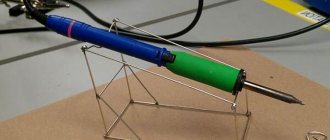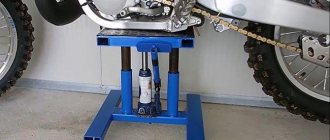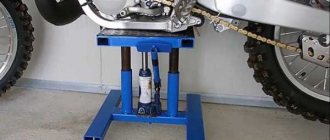Hi all. Besides owning a Mitsubishi Airtrek, life has given me the opportunity to love motorcycles. I didn’t get to the motor lift right away. Currently I work in a car service center and we decided to open a motorcycle station for motorcycles and quad vehicles. A quick search on the Internet showed outrageous prices, and the homemade products have questionable quality and, to be honest, appearance. I called for help from a friend who had worked for more than 10 years as a leading designer at a tractor factory. The result was a device with a safety margin for lifting an excavator. We have improved the reduction in product weight. The project is ready. I'm moving on to purchasing metal. Write critical comments and suggestions. Z.Y. The additionally installed “wings” for working with quads have been improved.
FakeHeader
Comments 51
There is no lock against unintentional lowering, high metal consumption, the frame will get in the way - you will constantly stumble, the wheel lock is inconvenient, there is no hatch for removing the rear wheel, with such a length of the hydraulic cylinder you will have trouble lifting it. We have already done more than one such thing. In the future, we will install hydraulic equipment for lifting “with a button.”
I didn’t see any safety elements (mechanical latches - catchers) ... someone’s leg will sooner or later get hurt, especially if you have pneumatics.
Do you mean the catchers during the lifting process? Most valuable advice! Thank you for your attention to my project!
This refers to clamps along the entire stroke of the lift so that if the cylinder fails, it does not fall.
Do you mean the catchers during the lifting process? Most valuable advice! Thank you for your attention to my project!
and here you can see the safety gear rack
I want the same one for the garage
Further, in garage conditions it is very difficult to assemble the levers. The point is that if there are large tolerances, then each pair of levers is assembled individually, where left-right, top-bottom is marked. The holes in the levers are sharpened in one pass, otherwise there will be a difference in distances and the structure will move. The mortgages must be welded together with another lever through the king pin. Maybe this is not important for a motorcycle, but I have a 3-ton lift and a 25 mm kingpin. Therefore, the general advice is minimal tolerances, laser cutting of the material with an almost tight fit.
There are many nuances to the chosen lift design: - the most problematic thing is calculating the force on the rod. It is a mistake to believe that a cylinder located in a lever system at an angle, creating a force of 1 ton, lifts a weight of 1 ton. For example, in my lift geometry to lift 3 tons from a height of 0 mm = the force is 144 tons without taking into account friction, t .e. the lift will not budge. Starting from 20 cm - 6 tons, at a height of 110 cm the coefficient becomes less than one, and in order to maintain 3 tons, the force on the hydraulic cylinder rod is less than 3 tons. In other words, it’s not a simple calculation; in the process, many options for placing the hydraulic cylinder, indents , lever lengths, etc. In the table it looks cruel, sheer foul language...
Well, thank you. I'll discuss this with my designer now.
There are many nuances to the chosen lift design: - the most problematic thing is calculating the force on the rod. It is a mistake to believe that a cylinder located in a lever system at an angle, creating a force of 1 ton, lifts a weight of 1 ton. For example, in my lift geometry to lift 3 tons from a height of 0 mm = the force is 144 tons without taking into account friction, t .e. the lift will not budge. Starting from 20 cm - 6 tons, at a height of 110 cm the coefficient becomes less than one, and in order to maintain 3 tons, the force on the hydraulic cylinder rod is less than 3 tons. In other words, it’s not a simple calculation; in the process, many options for placing the hydraulic cylinder, indents , lever lengths, etc. In the table it looks cruel, sheer foul language...
For 114 tons of force and with a pressure in the pneumatic system of 6 kg/cm2, the piston diameter of the pneumatic cylinder needs 1556 mm. More than one and a half meters, [swearing is prohibited]! As they say, we wish success to the designer in this endeavor :)))
Read also: Draw a BMW car step by step
What does swearing have to do with it? read carefully - such working conditions do not exist and are not expected; not a single power hydraulic scissor lift will lift your load from 0 mm when the cylinder is in an almost horizontal position. The lift always first goes through the vehicle's clearance height, and then also the suspension travel.
By the way, the starter’s top in the last photo is also no longer 0 in height.
I fully support you, you are right. And the cylinder is not horizontal, and the triangles of the scissors do not add up to zero. I wrote this more for the author, so that he would be imbued with the idea and think in the direction of hydraulics, otherwise at some point in the climb (as you quite rightly noted), the force transfer coefficient becomes less than unity and, due to the property of gas to expand unlimitedly, the table with the motorcycle first shoots up , and then crushes the structure into the floor, which will not happen with hydraulics due to the inextensibility and incompressibility of the liquid. And the areas of the pistons differ significantly, due to the difference in permissible pressure.
Is that a hydraulic cylinder or a gas shock absorber?
So far the pneumatic cylinder has been designed. The auto repair shop has a compressor.
Are the legs secured in the raised (or intermediate) position? It’s just that pneumatics are not rigid and can swing. The legs must be fixed.
There are locks for the raised position (you can see it in the 1st picture below).
Is the motorcycle stable only due to the clamping of the wheel and the stand?
No. There will be additional fastenings.
What comments might there be? The design is workable, you are satisfied, and you will know better about improvements during operation.
It’s a cool thing, but you’ll have to make a bunch of different adaptations for it to attach and lift various equipment, something that is not suitable for a chopper for sports and endurikes, and so on.
I will make a motorcycle lift for large and expensive motorcycles. I believe that those who ride scabies and endurics repair themselves “on their knees”. My carrying capacity is about 500-600 kg.
Yes, well, the goose is also enduro, but I think it will be difficult to repair it and there are different types of scabies. Good luck in mass production, I already tried it, it’s a rotten idea.
Geese - yes. By the way, I got the idea from the BMW forum.
This is the one that wobbles a lot and pneuma of reasonable dimensions will not lift it.
Geese - yes. By the way, I got the idea from the BMW forum.
So how can we work on this? Press down a little and pick up the broken glass from the floor
I will make a motorcycle lift for large and expensive motorcycles. I believe that those who ride scabies and endurics repair themselves “on their knees”. My carrying capacity is about 500-600 kg.
“My carrying capacity is about 500-600 km.
"O_o Why so high? knock down satellites and make money by selling space scrap metal? :)))
Oppa. :))) Thanks for the mistake. Corrected.
“My carrying capacity is about 500-600 km.
"O_o Why so high? knock down satellites and make money by selling space scrap metal? :)))
so high? For this reason, such a height allows you to work with the motorbike straight, without bending! If you bend over all day to repair, your back gets stiff and tired! If you want, you can sit on a stool without bending again!
:))) No, the person made a mistake there, he measured the load capacity in kilometers










